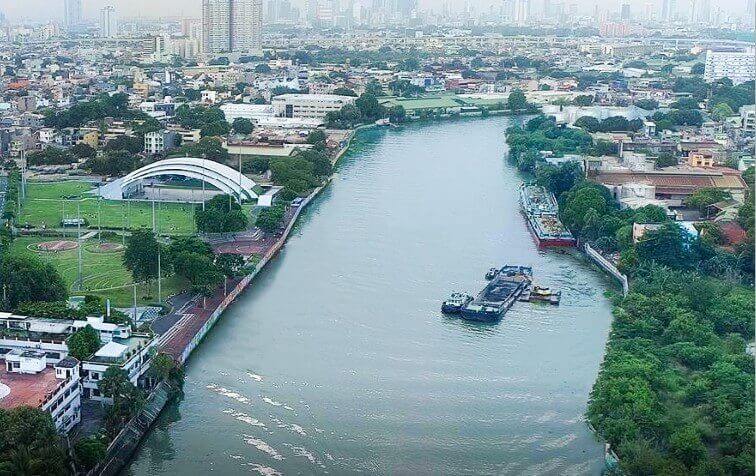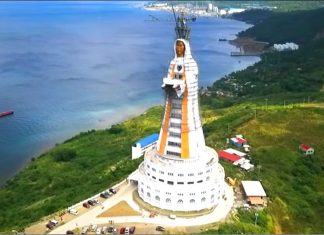
A breakthrough for Philippine environmental action is being marked this July with a two-year massive cleanup drive in critical sections of the Pasig River nearing its 1.5 million tons of waste removal target to help increase its depth, promote faster water flow, and lessen chances of severe flooding in nearby communities.
The Pasig River cleanup project is well on its way to the finish line with over 1.3 million tons of silt and solid waste removed from the Pasig River as of July 6, 2023. The overall goal to dispose of 1.5 million tons of trash is projected to be fulfilled by August this year, reported San Miguel Corporation (SMC), the lead organization in the project.
The Pasig River is a 27-kilometer waterway stretching from Manila Bay to Laguna Lake which served as the main route for transport, trade, and cultural exchange since the pre-colonial and Spanish era in the Philippines. It was declared biologically dead in the 1990s after decades of rapid urbanization and industrialization in Metro Manila. It is infamous for large-scale plastic pollution.
In 2021, the American Association for the Advancement of Science proclaimed that it was “the world’s most polluting river when it comes to plastic”. Fishing in the river had previously halted in the 1980s due to the river’s rising environmental hazards.
To this day, plastic waste is a crucial point of contention throughout the country’s waters. One-time-use sachets and plastic cutlery have been hailed as the twin culprits of sea degradation, as the Philippines is currently ranked as the third worst polluter of the ocean.
The SMC-led cleanup project implemented in 2021, is being conducted in tandem with the Department of Environment and Natural Resources (DENR) and other government agencies at no cost to the government. The project is in support of the Manila Bay rehabilitation effort and is part of an ongoing plan to build the Pasig River Expressway (PAREX). The planned elevated expressway aims to connect eastern and western Metro Manila. By bypassing the gridlock throughout the National Capital Region (NCR), the project promises a 15-minute travel time from Manila to Rizal.
https://twitter.com/scvannasummer/status/1678338627816890369
The two-year project had the goal of removing 600,000 metric tons of waste annually. The move is seen to greatly improve the welfare of NCR inhabitants as well as communities around the neighboring Laguna Lake.
SMC President and CEO Ramon S. Ang said, “More than the number of silt and solid waste removed from the river, we would like to emphasize the benefits of the river cleanup, such as the increase in its depth, and the widening of some narrow portions that have resulted in greater river capacity, faster water flow, and lesser chance of severe flooding, particularly in vulnerable communities near the River.”
Metro Manila is greatly susceptible to flooding disasters, affecting millions of citizens’ economic mobility. So far, the cleanup project has expanded the depths of certain parts of the river from 0.5 to 1.5 meters to 2.5 to 4 meters. This gives the river a heightened capacity to accept floodwaters.
Three years ago, the rehabilitation of the connecting San Juan River led to a smaller incidence of flooding in the area – prompting hopes that the cleanup of the Pasig River will lead to similar outcomes. “Dati-rati, umaabot sa isa o dalawang palapag yung baha. Umuulan pa lang ay nagsisimula na kaming mag-akyat ng gamit. Pero ngayon di na masyado mataas ang tubig kaya wala na kami masyadong pangamba,” Quezon City resident Reynaldo Balili attested.
(In the past, floodwaters would reach one or two storeys high. Whenever the rain would start, we would begin moving all our belongings upstairs. But now, floodwaters are not as high, so we are not as alarmed.)
San Miguel Corporation is also cleaning up the San Juan River, which connects to the Pasig River. Ang added that SMC is now eyeing to further improve its river cleanup activities in Bulacan province, following its experience in the Tullahan River and Pasig River.
In 1999, the Pasig River Rehabilitation Commission was established to lead in the revival of the Pasig River and has since established projects for riverbanks development, solid waste management, water quality improvement, and public awareness. The Pasig River Coordinating and Management Office now takes the lead in overseeing cleanup efforts.
The Pasig River rehabilitation project was named the most noteworthy endeavor in Asia in 2018 and earned the first Asia Riverprize, the world’s foremost award in river basin management. In 2019, the Jones Bridge over the Pasig River was beautified by the Manila City government. In 2020, the Pasig River Ferry continued its free rides for commuters.
Want to know how to be a Proud Pinoy? Like, Follow, Subscribe to GoodNewsPilipinas.com and our socials Facebook, Twitter, Instagram, Good News Pilipinas! TV on YouTube, for new good story notifications and e-mail newsletters for updates on more Filipino Pride stories.










